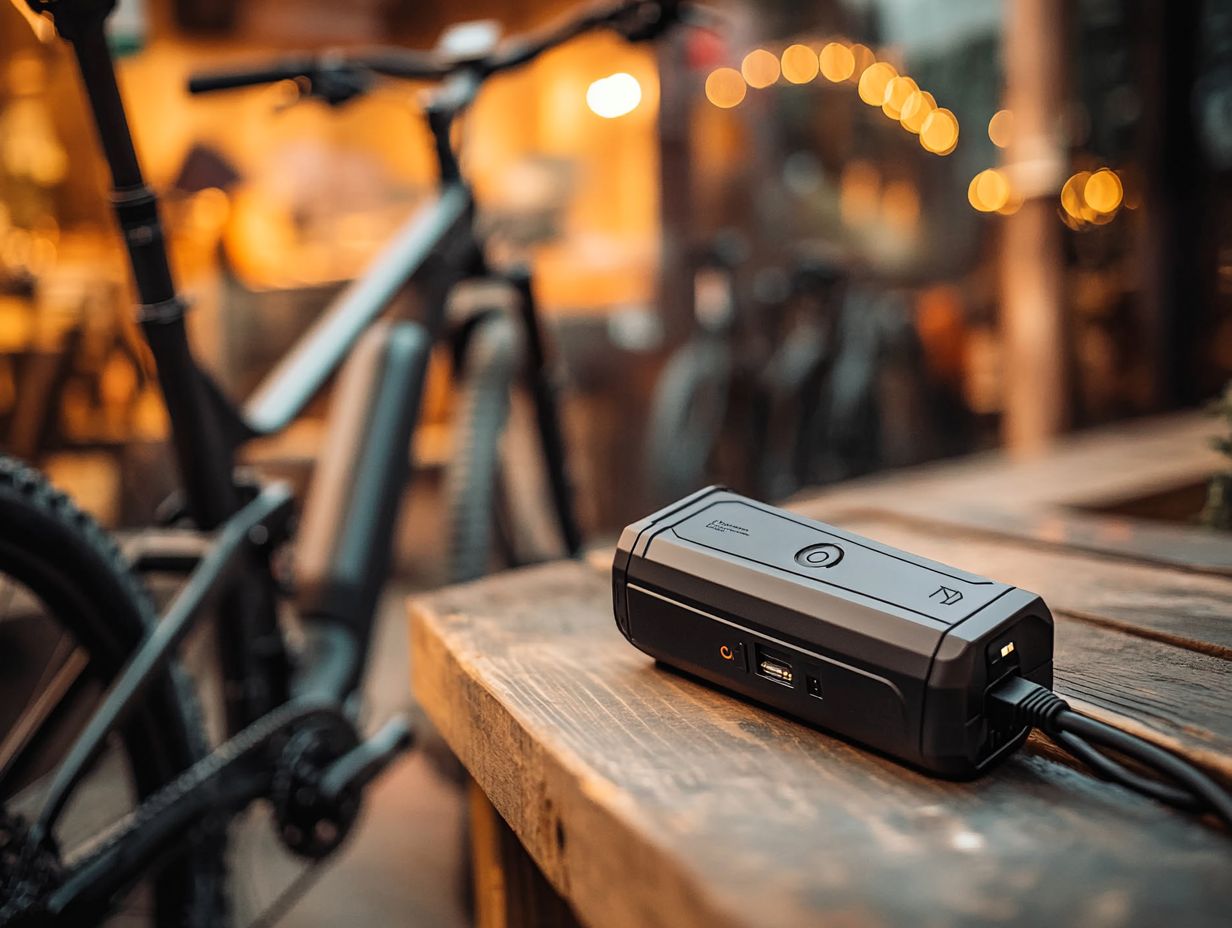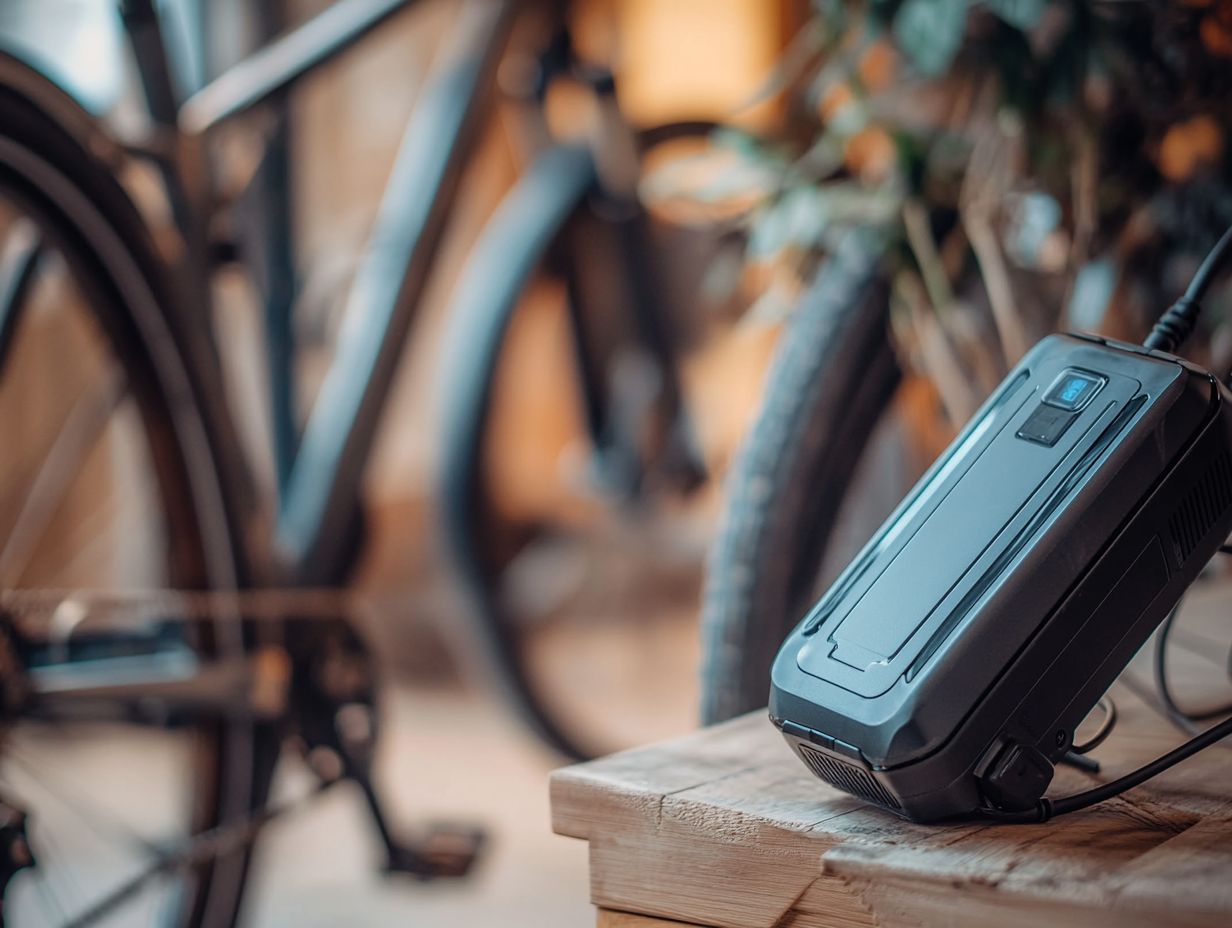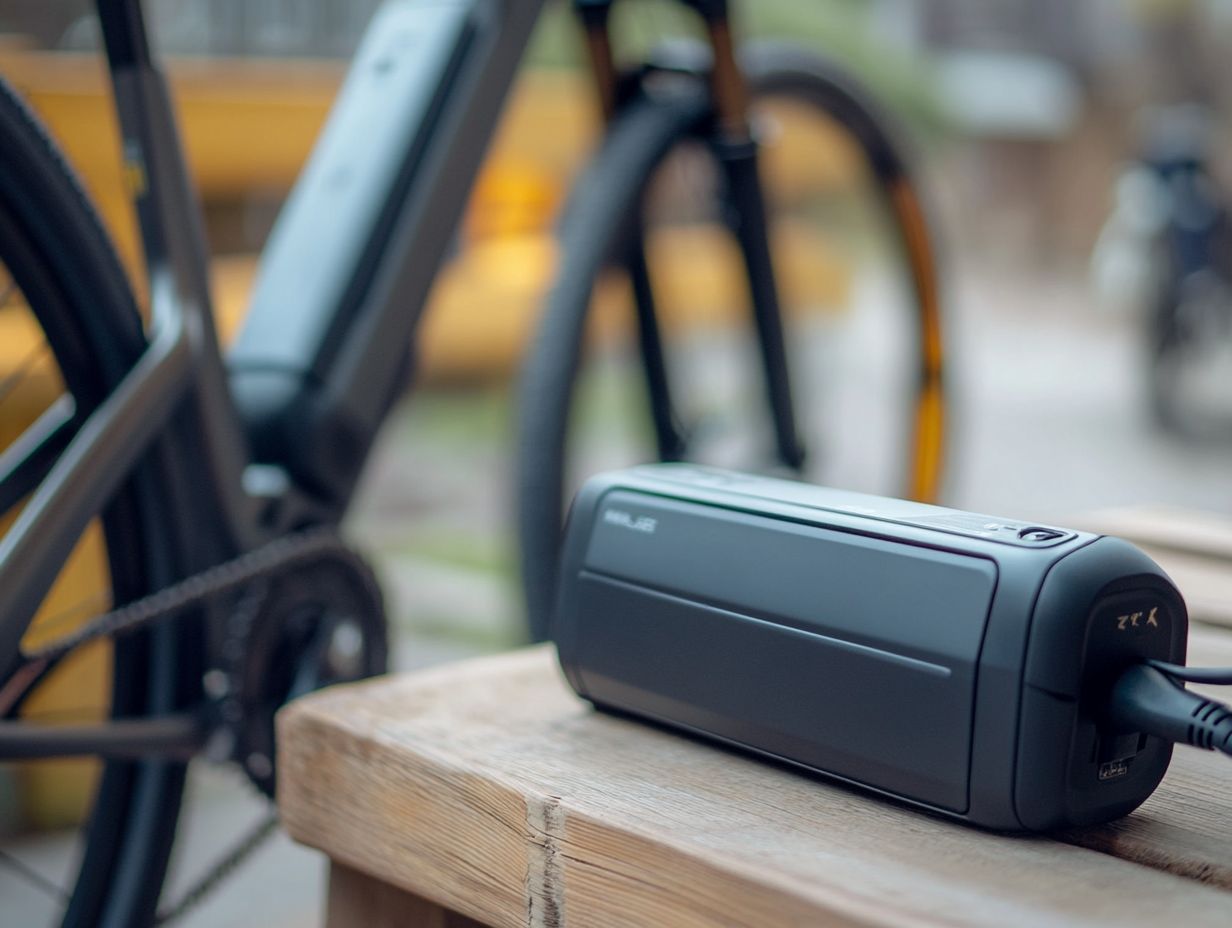What is the Lifespan of an E-Bike Battery?
Unlock the full potential of your rides by mastering e-bike batteries! E-bike batteries serve as the heartbeat of your electric bicycle, fueling your adventures with unmatched vigor. Grasping the nuances of their types, lifespan, and maintenance can transform your e-biking experience into something truly exceptional.
This exploration delves into the various types of e-bike batteries, the factors that impact their longevity, and the industry standards that govern performance. It also offers valuable tips on extending battery life, best practices for replacements, and essential considerations for budgeting and environmentally responsible disposal.
Dive in now to discover how to supercharge your e-bike experience!
Contents
- Key Takeaways:
- Understanding E-Bike Batteries
- Average Lifespan of E-Bike Batteries
- Extending the Lifespan of E-Bike Batteries
- Replacing E-Bike Batteries
- Costs and Considerations for Battery Replacement
- Frequently Asked Questions
- How often should I charge my e-bike battery?
- Can I replace an e-bike battery?
- How do I properly store my e-bike battery?
- Is it safe to leave my e-bike battery charging overnight?
Key Takeaways:

- E-bike battery lifespan is affected by factors such as temperature, usage frequency, and charging habits.
- On average, e-bike batteries last 2-4 years, but this can vary depending on brand, type, and usage.
- Proper charging, storage techniques, and regular maintenance can extend the lifespan of an e-bike battery.
Understanding E-Bike Batteries
Understanding e-bike batteries is essential for ensuring the longevity and reliable performance of your electric bike, especially if you’re riding models like the Himiway that use high-quality Lithium-ion batteries.
These batteries play a crucial role in the overall lifespan of your e-bike. It’s important for you to be informed about their types, maintenance requirements, and charging habits. For a deeper understanding, check out understanding e-bike battery lifespan. Using proper lubrication and cleaning tips can keep them in top condition.
With advancements in battery technology that include high-quality components and premium materials from reputable brands like Panasonic and Bosch, it s vital for you to appreciate the significance of selecting the right battery and maintaining its quality. This knowledge will enable you to achieve optimal performance and enjoy your rides to the fullest.
Types of E-Bike Batteries
E-bike batteries predominantly feature Lithium-ion technology. This type of battery is known for being lightweight and efficient, making it the top choice for prestigious manufacturers like Panasonic and Bosch, who strive to deliver exceptional performance in electric bikes.
You ll find that Lithium-ion batteries come with numerous benefits, notably a longer lifespan compared to traditional lead-acid batteries and quicker charging times. This makes them perfectly suited for today s fast-paced commuters.
Emerging technologies like solid-state batteries which use solid materials instead of liquid electrolytes are gaining momentum, offering even greater energy storage capacities and improved safety features. This makes them a compelling choice for electric bike users.
These innovations enhance the range of electric bikes and boost their overall efficiency, enriching your riding experience. As e-bikes continue to capture the mainstream market, advancements in battery technology are revolutionizing their use across various sectors, from urban commuting to leisurely rides.
Factors Affecting Battery Lifespan
The lifespan of your ebike battery hinges on several key factors, including the quality of the batteries themselves, your charging habits, and environmental conditions, such as temperature. Each of these elements plays a vital role in determining how long your electric bike will deliver optimal performance.
Additionally, the frequency of use and the type of terrain you tackle, whether it s hilly paths or flat roads, can significantly influence battery longevity. Investing in high-quality components from reputable manufacturers ensures superior performance and enhanced durability.
By adopting best practices for battery care such as avoiding full discharges and keeping your battery away from extreme temperatures you can meaningfully impact its lifespan. Regularly checking connections and maintaining optimal charging cycles are essential steps every ebike owner should prioritize to maximize battery life and efficiency, ensuring you enjoy countless rides.
Average Lifespan of E-Bike Batteries
The average lifespan of e-bike batteries can differ. However, industry standards, like the UL2849 certification, indicate that a well-maintained battery generally lasts between 3 to 5 years.
This is particularly true for models that meet UL2849 certification, such as those offered by Himiway electric bikes, ensuring they adhere to safety and performance standards.
Familiarizing yourself with these standards allows you to set realistic expectations for battery performance and longevity. This is essential whether you’re a casual rider or a dedicated enthusiast, especially if you want to know how often to replace your e-bike battery for frequent commuting or recreational purposes.
Industry Standards and Expectations

Industry standards, like the UL2849 certification, are crucial for ensuring the safety and performance reliability of electric bike batteries. This is especially true for reputable brands such as Himiway, which are dedicated to delivering high-quality products that meet or exceed these standards.
When you re in the market for e-bike batteries, you should rely on these certifications as essential indicators of quality and safety. The UL2849 certification covers vital aspects like electrical safety, thermal performance, and environmental impact, providing peace of mind to consumers.
By adhering to these standards, manufacturers increase consumer confidence and enhance battery longevity and efficiency. These are key factors for riders who demand reliable performance on their journeys. As a result, these standards have elevated consumer expectations, creating a competitive landscape that promotes innovation while ensuring that all products are both safe and functional.
This is especially important for products featuring advanced technologies like torque sensors and hydraulic brakes.
Extending the Lifespan of E-Bike Batteries
To extend the lifespan of your e-bike batteries, it s essential to adopt proper charging and storage techniques. Regular maintenance, including component inspection and tire maintenance, is equally important to ensure that your batteries operate optimally.
By following these practices, you can significantly prolong the life of your batteries.
Proper Charging and Storage Techniques
Proper charging habits and storage techniques are crucial for extending your battery’s life. For example, keeping your e-bike battery at a moderate temperature and avoiding complete discharges can significantly enhance both performance and longevity.
Understanding that lithium-ion batteries which are rechargeable and widely used in e-bikes for their efficiency thrive in temperatures ranging from 20 C to 25 C enables you to make informed choices about where to charge and how to store your battery.
Extreme heat can lead to accelerated degradation, while chilly conditions may temporarily reduce the battery’s efficiency and capacity, which is vital for maintaining an optimal riding experience with your electric bike. To understand how environmental factors affect your ride, consider looking into what is the average lifespan of an e-bike.
It’s wise to unplug the charger as soon as the battery reaches full capacity. Overcharging can shorten its lifespan. Regularly monitoring the battery s state of charge and keeping it between 20% and 80% will help optimize performance and prolong battery life.
These practices are crucial for all electric bike owners. By implementing best practices, including proper lubrication and regular maintenance, you can ensure that your e-bike batteries remain robust and reliable for countless rides to come.
Replacing E-Bike Batteries
Replacing e-bike batteries is a crucial consideration for you as an electric bike owner. When seeking a long-lasting battery that guarantees optimal performance reliability, look at reputable brands like Himiway, known for their quality components and dependable performance.
These models often feature fat tires for added stability, ensuring a reliable and enjoyable ride.
When and How to Replace a Battery
Knowing when and how to replace your electric bike’s battery is essential for maintaining its performance and reliability. Signs like a diminished range or overheating often signal that it’s time for a replacement. This is especially true if you use your bike frequently for transportation.
Pay attention to frequent charging cycles and any visible damage to the battery casing. These can indicate underlying issues that require your attention. When evaluating the need for a battery replacement, consider the overall performance of your bike, including how it responds when you pedal, along with any unusual sounds or leaks from the battery compartment.
Once you’ve determined that a replacement is necessary, selecting a high-quality battery becomes crucial for optimal functioning. Seek out reputable brands that adhere to safety standards, like UL2849. Always follow the manufacturer s guidelines for installation. Don’t forget to properly dispose of the old battery to protect the environment and minimize your impact.
Costs and Considerations for Battery Replacement

When you contemplate replacing the battery for your electric bike, it s crucial to assess the associated costs and budget wisely. Consider eco-friendly disposal methods for your old batteries. This thoughtful approach helps you manage expenses while also minimizing your environmental footprint, ensuring responsible choices.
Budgeting for Replacement
Budgeting for battery replacement is important for electric bike owners, as costs can vary significantly based on the type of long-lasting battery you choose and the quality of the components involved, including warranties and brand reputation.
Understanding these variations enables you to plan effectively and avoid unexpected expenses. Factors influencing the cost of a new battery include capacity, brand reputation, and warranty offerings.
While the upfront price is important, don’t overlook the potential long-term savings associated with investing in high-quality options. Cheaper alternatives might catch your eye, but they often lead to higher maintenance costs and shorter lifespans. By prioritizing durability and performance, you can ensure that your investment pays off over time, keeping your electric bike running smoothly and efficiently.
Eco-Friendly Disposal of Old Batteries
Eco-friendly disposal of old batteries is essential for minimizing your environmental impact, particularly regarding lithium-ion batteries found in electric bikes, such as those from Himiway. These batteries demand careful handling and recycling.
Improper disposal can allow toxic substances to leach into the soil and waterways, creating serious risks for both ecosystems and human health. Many communities are waking up to this urgent issue, making participation in local recycling programs more important than ever.
By opting for certified recycling facilities, you can ensure that your batteries are handled and recycled safely, significantly reducing potential harm.
Grasping and utilizing proper disposal methods not only promotes sustainability but also nurtures a culture of accountability, enabling you and others to contribute to the protection of our planet s resources for future generations.
Frequently Asked Questions
What is the Lifespan of an E-Bike Battery?
The lifespan of an e-bike battery can vary depending on several factors, such as usage, storage, and battery quality. On average, an e-bike battery can last anywhere from 2 to 4 years.
What factors can affect the lifespan of an E-Bike Battery?

The main factors impacting the lifespan of an e-bike battery include usage, storage, and battery quality. Frequent use and exposure to extreme temperatures can decrease battery lifespan, while proper storage and a high-quality battery can extend it.
How often should I charge my e-bike battery?
Charge your e-bike battery after every use. If you re not riding regularly, charge it at least once a month to keep it healthy and extend its lifespan.
Can I replace an e-bike battery?
Yes, you can replace an e-bike battery. Just remember, not all batteries fit every e-bike model. Always check with the manufacturer or a professional to ensure compatibility.
How do I properly store my e-bike battery?
Store your e-bike battery in a cool, dry place. Keep it at about halfway charged when not in use to maintain its health.
Is it safe to leave my e-bike battery charging overnight?
It s generally safe to charge your e-bike battery overnight. Just be sure to check on it occasionally and don t leave it unattended for too long.






